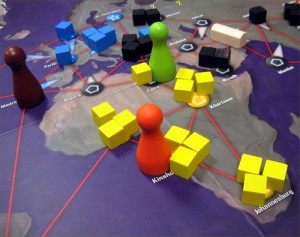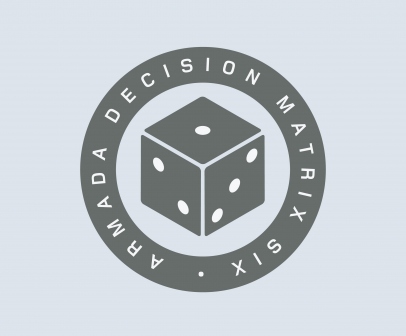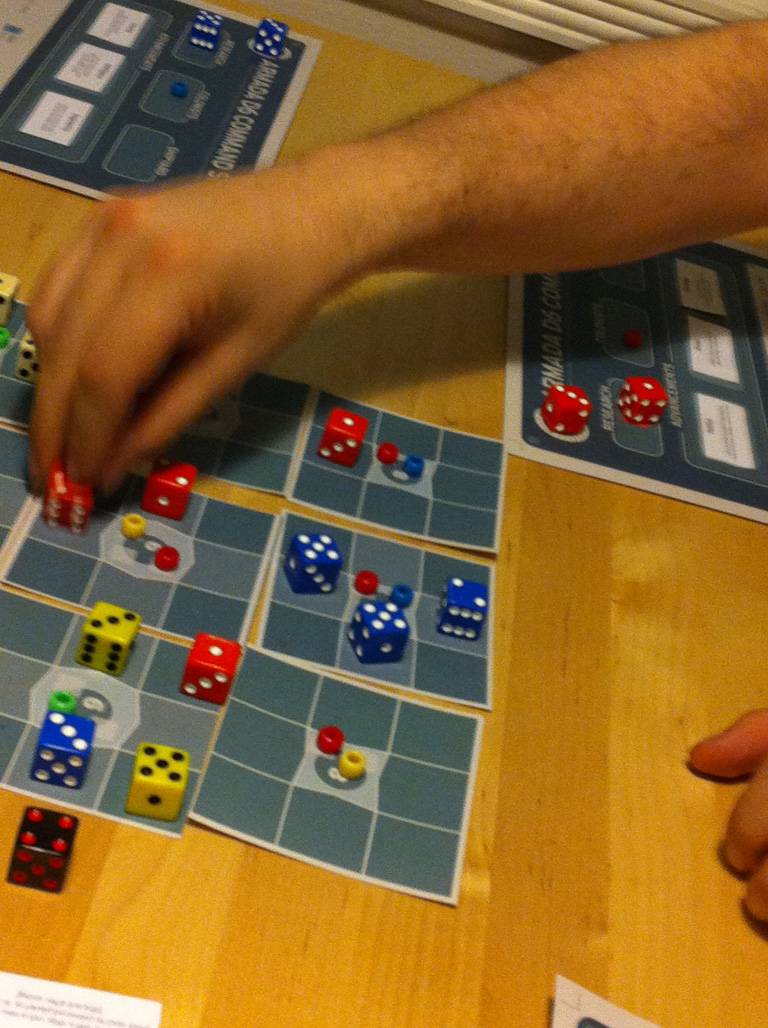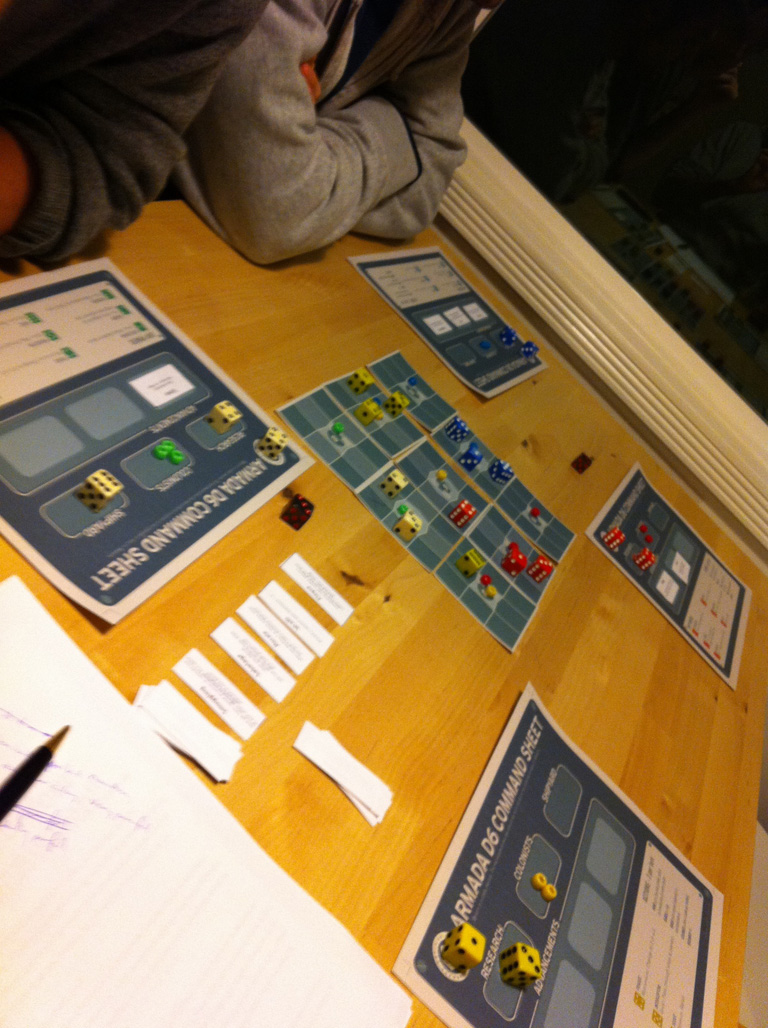natural disasters in NEOM
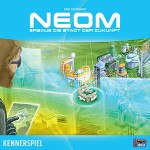 I was recently in Essen for the release of NEOM, which is what the game previously known as Draftopolis or City Draft (written about extensively here and mentioned briefly here) has become after being published by Lookout Games. And while overall I've been overjoyed with the response, I've seen a few comments from people who dislike the inclusion of the disaster tiles in the game, and I realized that I haven't ever sat down to write out my thoughts for why I included the mechanic despite knowing that those tiles would be controversial. Without further ado, here's what I was thinking:
I was recently in Essen for the release of NEOM, which is what the game previously known as Draftopolis or City Draft (written about extensively here and mentioned briefly here) has become after being published by Lookout Games. And while overall I've been overjoyed with the response, I've seen a few comments from people who dislike the inclusion of the disaster tiles in the game, and I realized that I haven't ever sat down to write out my thoughts for why I included the mechanic despite knowing that those tiles would be controversial. Without further ado, here's what I was thinking:
1. Theme
First off, they're a thematic home run for anyone who's played SimCity, and even for those who haven't they tend to be very relatable. Of course you would have to plan around natural disasters if building a city! The relationship with Fire and Police Departments is also apparent, and those are a natural way for adjacency (and therefore placement) to matter, which makes the city grid more interesting.
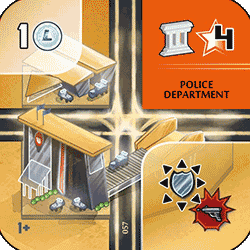 The different effects of the individual disaster tiles are also very thematic - when calculating penalties, all of them only count (i.e. cause damage to) building tiles, as that's what a city would largely be responsible for. In addition, Crime Spree doesn't count Public tiles, as who's going to rob a government building or a power plant? Fire is unique in that it allows Resource tiles to be sacrificed, given that it's easy to imagine the Raw Goods burning away (particularly in the case of Wood or Oil!). Each of these differences will come into play in how best to prepare and deal with the individual disasters, giving each Generation of the game a different flavor.
The different effects of the individual disaster tiles are also very thematic - when calculating penalties, all of them only count (i.e. cause damage to) building tiles, as that's what a city would largely be responsible for. In addition, Crime Spree doesn't count Public tiles, as who's going to rob a government building or a power plant? Fire is unique in that it allows Resource tiles to be sacrificed, given that it's easy to imagine the Raw Goods burning away (particularly in the case of Wood or Oil!). Each of these differences will come into play in how best to prepare and deal with the individual disasters, giving each Generation of the game a different flavor.
2. Risk/Reward
 Without disasters in the game, there would be very little tension to how you build your city. Residential strategies, for example, would be about blindly taking every Residential tile you see and fitting them together in whatever configuration comes together. But with disasters in play, the greedier (i.e. heavy Residential or to some extent heavy Industrial) strategies become much more interesting - do you take that Residential tile knowing that you won't be able to afford the Fire if it happens this turn? Do you let your neighborhood grow as quickly as possible in all directions, knowing that will make it harder to protect with Fire and Police Departments, or do you try and keep it contained to one area of the city?
Without disasters in the game, there would be very little tension to how you build your city. Residential strategies, for example, would be about blindly taking every Residential tile you see and fitting them together in whatever configuration comes together. But with disasters in play, the greedier (i.e. heavy Residential or to some extent heavy Industrial) strategies become much more interesting - do you take that Residential tile knowing that you won't be able to afford the Fire if it happens this turn? Do you let your neighborhood grow as quickly as possible in all directions, knowing that will make it harder to protect with Fire and Police Departments, or do you try and keep it contained to one area of the city?
In addition, there are a variety of mitigation strategies available in the game that I'll discuss later - but discovering how to best execute these is a significant contributor to why the game has as much depth as it does, and why there are 13 people who have each completed over 100 games in the online prototype (not even counting solitaire or bot games!). Even once you've mastered these strategies you'll find that there are certain Cornerstone tiles that will tempt you into making risky plays once again, and sometimes you'll get away with them, and sometimes you won't.
3. Psychology
So why don't the disasters just happen automatically at the end of the generation or whatever? Well, if you play with the same group of players consistently, you can start to learn their tendencies as to how much they like playing disasters. Once you've seen the disaster tile for a given Generation, you can track it as it moves around the table, and weigh whether each person might want to take it (based on a combination of their proclivities and their own vulnerability to that disaster - with higher vulnerability making them more likely to pull the trigger).
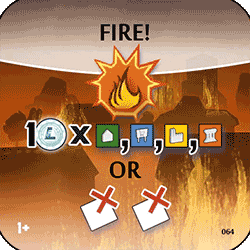 Relatedly, there are two ways in which disasters directly provide psychological tension for players who understand when they're currently vulnerable: 1. when a new Generation is starting and the packs are being dealt out (as you hope to open the disaster so that you can play it before anyone else) and 2. when you're knowingly leaving yourself vulnerable and hoping no one punishes you for it as the packs move around the table. Granted, this requires knowing what the disaster for the current era will do without having it in front of you, so I do wish that the game had included some reference cards with that information - but in the meantime you can download a Disasters + Cornerstone Icons reference card that I've uploaded to BoardGameGeek.
Relatedly, there are two ways in which disasters directly provide psychological tension for players who understand when they're currently vulnerable: 1. when a new Generation is starting and the packs are being dealt out (as you hope to open the disaster so that you can play it before anyone else) and 2. when you're knowingly leaving yourself vulnerable and hoping no one punishes you for it as the packs move around the table. Granted, this requires knowing what the disaster for the current era will do without having it in front of you, so I do wish that the game had included some reference cards with that information - but in the meantime you can download a Disasters + Cornerstone Icons reference card that I've uploaded to BoardGameGeek.
4. Interaction
In 7 Wonders, when you can see that someone across the table is doing incredibly well, there's nothing you can do about it other than plead with the people next to them to take the tiles that their strategy desires (usually science). In NEOM, when someone is doing particularly well (usually as a result of a greedy strategy like heavy Residential), you can always hope to pick a disaster tile that takes them down a notch.
That said, it was very important to me that the disasters in NEOM are non-targeted (similar to Attack cards in Dominion). When games have targeted attacks, discussions often devolve into multiple players trying to convince the table that they're not doing well, which I find tedious at best and downright annoying at worst (it especially bothers me that I can't help but engage in this as well, as it's the right play if you're trying to win - a particular game of Small World with my brother comes to mind!).
So as I mentioned earlier, there are actually a variety of ways to handle disasters in NEOM, and learning them is a big part of improving as a player. Here are the major categories, from the most self-evident to the least:
1. Organize around Fire and Police Departments
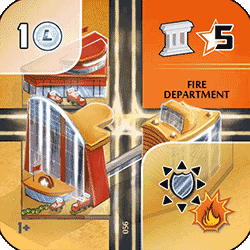 Unsurprisingly, building around the tiles that specifically protect against disasters will greatly reduce your vulnerability. The trick here is that you'll have to arrange the rest of your city to maximize how many relevant tiles each Department can hit. This means surrounding your Fire Departments with buildings of any type and, more importantly, your Police Departments with just Residential, Commercial, and Industrial tiles. That's sometimes easier said than done, however, so one effective technique can be to just focus your tiles of those types around your City Center, and then take advantage of the covering rules to place a Police Department on top of the City Center either late in the 2nd Generation or early in the 3rd.
Unsurprisingly, building around the tiles that specifically protect against disasters will greatly reduce your vulnerability. The trick here is that you'll have to arrange the rest of your city to maximize how many relevant tiles each Department can hit. This means surrounding your Fire Departments with buildings of any type and, more importantly, your Police Departments with just Residential, Commercial, and Industrial tiles. That's sometimes easier said than done, however, so one effective technique can be to just focus your tiles of those types around your City Center, and then take advantage of the covering rules to place a Police Department on top of the City Center either late in the 2nd Generation or early in the 3rd.
2. Invest heavily in Resources
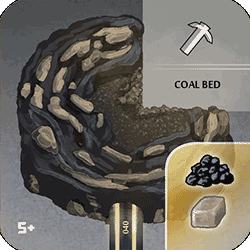 One aspect that makes Resource tiles much better than they might originally seem is that they aren't vulnerable to any of the three disasters, meaning that someone who invests heavily in them will have much more manageable penalties than someone who doesn't. In addition, other players are liable to buy the Raw Goods from you, which can add up even if the individual trades are only worth an L-Coin or two (and players are much more likely to be willing to shell out for the cheaper Raw Goods than they are for Goods from the more expensive tiers!). Finally, Public tiles are also notable in that they dodge Crime Spree, so a city focused around those (perhaps with Civic Center) will have a much easier time overall, even without Fire or Police Departments.
One aspect that makes Resource tiles much better than they might originally seem is that they aren't vulnerable to any of the three disasters, meaning that someone who invests heavily in them will have much more manageable penalties than someone who doesn't. In addition, other players are liable to buy the Raw Goods from you, which can add up even if the individual trades are only worth an L-Coin or two (and players are much more likely to be willing to shell out for the cheaper Raw Goods than they are for Goods from the more expensive tiers!). Finally, Public tiles are also notable in that they dodge Crime Spree, so a city focused around those (perhaps with Civic Center) will have a much easier time overall, even without Fire or Police Departments.
3. Prioritize tiles with instant benefits
 At first blush, a tile like Pawn Shop might seem significantly worse than other Commercial tiles like Laundromat - the former gives $5 immediately, but the latter will give $9 over the course of the game, equivalent to an extra 2 VPs. And without disasters, that would generally be true, but that's where the second option on each disaster tile comes in. Instead of paying money, you can always choose to sacrifice tiles, even if you have enough money on hand. And there's next to no drawback to sacrificing a tile like Pawn Shop that has already provided all of its value up front. So when you consider that a Flood might cost you $5 or $6, and you add those savings to Pawn Shop's immediate $5, it actually ends up providing more overall money than Laundromat in many situations.
At first blush, a tile like Pawn Shop might seem significantly worse than other Commercial tiles like Laundromat - the former gives $5 immediately, but the latter will give $9 over the course of the game, equivalent to an extra 2 VPs. And without disasters, that would generally be true, but that's where the second option on each disaster tile comes in. Instead of paying money, you can always choose to sacrifice tiles, even if you have enough money on hand. And there's next to no drawback to sacrificing a tile like Pawn Shop that has already provided all of its value up front. So when you consider that a Flood might cost you $5 or $6, and you add those savings to Pawn Shop's immediate $5, it actually ends up providing more overall money than Laundromat in many situations.
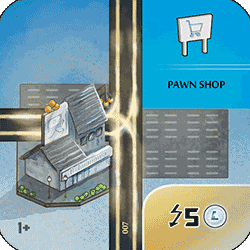 This can occasionally backfire, though, if no one plays the Flood in the first Generation and then you end up having to pay for your Pawn Shop when Fire and/or Crime Spree ends up happening. Your best option in that case is probably to sacrifice it to the Fire along with one of your Resource tiles (as unlike Flood or Crime Spree, Fire allows the sacrificing of any tile). Another interesting option, if it becomes clear that it's about to cost you additional money in a Crime Spree, is that you can always play another Commercial tile on top of it, thereby reducing your overall vulnerability.
This can occasionally backfire, though, if no one plays the Flood in the first Generation and then you end up having to pay for your Pawn Shop when Fire and/or Crime Spree ends up happening. Your best option in that case is probably to sacrifice it to the Fire along with one of your Resource tiles (as unlike Flood or Crime Spree, Fire allows the sacrificing of any tile). Another interesting option, if it becomes clear that it's about to cost you additional money in a Crime Spree, is that you can always play another Commercial tile on top of it, thereby reducing your overall vulnerability.
4. Skip a tile type entirely until after Crime Spree
 Crime Spree's alternative penalty is to sacrifice a Residential tile, a Commercial tile, and an Industrial tile. However, if you don't have one or more those tile types, you can ignore that portion of the penalty, making it a valid strategy to say, forego building any Residential tiles until after the Crime Spree occurs (which tends to be early in the Generation). If the Commercial tile that you sacrifice is a Pawn Shop or a Collection Agency, or if the Industrial tile that you sacrifice is one that's obsolete because you already produce that Good in another way (most commonly because you've built a Modern Factory or Modern Foundry), so much the better. In fact, with proper preparation it's very possible to only lose 1 or 2 VPs from your eventual score when sacrificing tiles to Crime Spree.
Crime Spree's alternative penalty is to sacrifice a Residential tile, a Commercial tile, and an Industrial tile. However, if you don't have one or more those tile types, you can ignore that portion of the penalty, making it a valid strategy to say, forego building any Residential tiles until after the Crime Spree occurs (which tends to be early in the Generation). If the Commercial tile that you sacrifice is a Pawn Shop or a Collection Agency, or if the Industrial tile that you sacrifice is one that's obsolete because you already produce that Good in another way (most commonly because you've built a Modern Factory or Modern Foundry), so much the better. In fact, with proper preparation it's very possible to only lose 1 or 2 VPs from your eventual score when sacrificing tiles to Crime Spree.
Lastly, if you're pursuing a Treasury strategy you may want to sacrifice tiles even if you'll have to lose a tile of all three types, because the most important thing for your city at that point is just your current money total, and if you can keep that high enough you can win despite losing a Residential, some income, and a Processed Good.
Despite all this, if you know that drafting disasters won't be a hit with your group, you could try either allowing them to be sold and discarded or just try replacing them with other tiles from a higher player count, and then and either have them always happen at the end of their respective Generation or just not happen at all. I actually haven't tested those variants, so if you do end up preferring them, or if you come up with another idea, please let me know in the comments!
P.S. If you're curious to try NEOM, feel free to check out the online prototype, or if you'd just like to read more about it, you can visit the BGG Page.
building a better drafting game
I've been fascinated by board games that revolve around drafting for years now, and in early 2011 I wrote a post on the pillars that make these games click. Not long after that I started working on a game (then called City Draft) that would be strongly inspired by a few key influences: 7 Wonders for the mechanics and structure, Carcassonne for the idea of placing tiles in a grid, and SimCity for the theme. I touched upon it briefly in an October 2011 post that said it was improving steadily, and I've been working on it off and on (under the name Draftopolis) ever since. I've created an online prototype for playtesting that has seen almost 2000 games completed with at least a dozen players clocking in at over 100 games apiece. The rapid feedback and iteration cycles enabled by this level of playtesting mean that the game is currently in fantastic shape.
I've also had years to mull over the design of Draftopolis, and I wanted to take some time to list out the improvements that I feel it makes over the game that first brought this genre to the forefront: 7 Wonders. Note that 7 Wonders is considered the 17th best board game of all time in the widely respected BoardGameGeek rankings, and I completely agree with that rating. I'm also a huge fan of the designer, Antoine Bauza, who has released several masterpieces of elegant design in the past few years. That said, no game is perfect, and here's a list of some issues I have with the game that I've tried to address:
1. Guilds are based largely on factors outside of your control.
For a variety of reasons, the decks for each age in 7 Wonders are fixed from game to game. The one exception is that each time you play, you randomly select some guilds to shuffle into the Age 3 deck. These guilds mostly provide variable point bonuses based on the types of buildings the players to your left and right have built. This means that finding effective guilds feels largely random since you can't plan your strategy around them and each individual guild is only good if your neighbors happen to be pursuing certain strategies. The best you can do to influence this is to ensure that you have the appropriate resources to play guilds that would be good for you, but even then there's a good chance that a given guild isn't in the deck at all.
 There's a large setup cost to having a selection of cards that are separately randomized at the start of each game, but with a few tweaks I felt that the potential payoff was more than worth it. The simple solution was to move the guilds to the first era (calling them "cornerstone" tiles instead) and to make them dependent on your own strategy rather than those of your neighbors. One example would be the Environmental Agency, which is a Civic building that grants victory points for spaces in your grid that 1) don't have a building and 2) have no nearby pollution. This leads to cities with wide open areas of undeveloped nature that either purchase all of their goods from other players or carefully position their industry in a corner surrounded by their other buildings. With 30 different cornerstone tiles that could show up, successive games of Draftopolis feel very different from start to finish.
There's a large setup cost to having a selection of cards that are separately randomized at the start of each game, but with a few tweaks I felt that the potential payoff was more than worth it. The simple solution was to move the guilds to the first era (calling them "cornerstone" tiles instead) and to make them dependent on your own strategy rather than those of your neighbors. One example would be the Environmental Agency, which is a Civic building that grants victory points for spaces in your grid that 1) don't have a building and 2) have no nearby pollution. This leads to cities with wide open areas of undeveloped nature that either purchase all of their goods from other players or carefully position their industry in a corner surrounded by their other buildings. With 30 different cornerstone tiles that could show up, successive games of Draftopolis feel very different from start to finish.
2. Science is purely all or nothing.
One of the core qualities of a solid drafting game is that players value the same cards significantly differently based on their position. In 7 Wonders, this manifests to an extreme with Science, which is nearly useless unless you commit heavily to it. Often you find yourself in a position where the player behind you is picking up Science cards and the game comes down to whether you're willing to spend early picks hate drafting them (torpedoing both your chances) or whether you let them through, nearly guaranteeing their victory. And if you choose the latter option, everyone at the table blames you for letting them win.
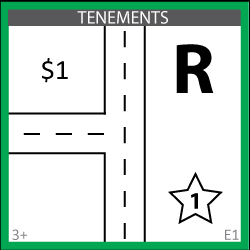 In Draftopolis the role of Science is filled by Residential tiles, which are worth increasing numbers of bonus points when they're placed contiguously into neighborhoods. The key difference is that I later stumbled onto the idea of including a thematically appropriate rule (called the "Ghost Town" penalty) that states that cities without any Residential tiles lose 10 points, and cities with only one lose 4 points. With this, all players have a large incentive to at least dabble in Residential and competition is ensured for the high value tiles within that category. In addition, the bonus flattens out after the eighth Residential in a neighborhood (rather than continuing to grow exponentially) so that even a player who gets all of the Residential tiles still needs to earn points in other categories to win the game.
In Draftopolis the role of Science is filled by Residential tiles, which are worth increasing numbers of bonus points when they're placed contiguously into neighborhoods. The key difference is that I later stumbled onto the idea of including a thematically appropriate rule (called the "Ghost Town" penalty) that states that cities without any Residential tiles lose 10 points, and cities with only one lose 4 points. With this, all players have a large incentive to at least dabble in Residential and competition is ensured for the high value tiles within that category. In addition, the bonus flattens out after the eighth Residential in a neighborhood (rather than continuing to grow exponentially) so that even a player who gets all of the Residential tiles still needs to earn points in other categories to win the game.
3. Few viable paths to victory.
In the base set of 7 Wonders, there are only a few strategies that can consistently win games: mainly heavy Science (when it's underdrafted), Military (with pacifist neighbors), or resource heavy (leading into some high value Civic buildings). The Commercial (yellow) strategy has a tough time winning due to the poor exchange rate of money to victory points (3 to 1) and heavy Civic (blue) strategies simply can't compete with other plans that end up earning points more efficiently. That said, the Leaders expansion does a wonderful job of fixing this problem without adding significant amounts of complexity.
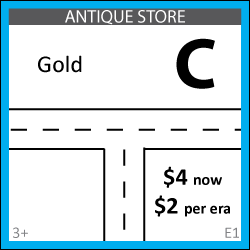 Draftopolis utilizes the cornerstone tiles and more favorable point conversions for money strategies (1 VP for each $2, with players capable of ending games well over $100) to open up the playing field. Residential-focused, Commercial-focused, and Industrial-focused strategies are all viable, as well as hybrid builds revolving around efficient tiles and/or one or more cornerstones. This display of the recent winning cities shows off the relative diversity of strategies that can do well.
Draftopolis utilizes the cornerstone tiles and more favorable point conversions for money strategies (1 VP for each $2, with players capable of ending games well over $100) to open up the playing field. Residential-focused, Commercial-focused, and Industrial-focused strategies are all viable, as well as hybrid builds revolving around efficient tiles and/or one or more cornerstones. This display of the recent winning cities shows off the relative diversity of strategies that can do well.
4. Limited play decisions.
After a card is picked in 7 Wonders, there are only three choices of what to do with it: play it, build a stage of your wonder, or sell it. As the wonder option is often unavailable due to resource constraints, and selling is rarely worthwhile, this leaves only one real choice most of the time.
 By contrast, Draftopolis features a 5x5 city grid that each player is independently filling with their tiles, with available trade routes on either side that provide benefits when a road is connected to them. The choice of where to play early tiles can play a crucial role in how a city develops into the mid and late game. A key decision that I settled on early in the process was that tiles can't be rotated, as the combinatorial possibilities of tiles, placements, and orientations would result in analysis paralysis for a lot of players. I do feel that the placement decision layer adds significant skill to the game, and it does so without adding too much time since everyone decides where to put their tiles simultaneously.
By contrast, Draftopolis features a 5x5 city grid that each player is independently filling with their tiles, with available trade routes on either side that provide benefits when a road is connected to them. The choice of where to play early tiles can play a crucial role in how a city develops into the mid and late game. A key decision that I settled on early in the process was that tiles can't be rotated, as the combinatorial possibilities of tiles, placements, and orientations would result in analysis paralysis for a lot of players. I do feel that the placement decision layer adds significant skill to the game, and it does so without adding too much time since everyone decides where to put their tiles simultaneously.
5. Static sell values and trade costs.
In 7 Wonders, cards in later ages are significantly more powerful and valuable than early age cards. Yet the return for selling a card remains $3 throughout, and selling a card in the third era (for the equivalent of 1 VP) is an almost surefire way to lose the game. Similarly, the cost for purchasing a resource is always $3, which is a massive commitment early game and a relatively small pittance late.
Draftopolis scales both the trade cost and the sell price throughout the game, increasing by $1 per era. This softens the "noob trap" elements of the sell option, and commodity-focused strategies are more rewarding since each sale will bring in the equivalent of 2.5 victory points in the final era.
EDIT: After playtesting this rule some more, I've changed the design to use a $5 static sell value and trade costs that only depend on the tier of the commodity being sold. Both of these values can be listed directly on the playmat and players don't have to go through an additional step to calculate the cost or benefit of a potential trade or sale.
6. Players can only interact with their direct neighbors.
Being sandwiched between two resource light players in 7 Wonders can be devastating, as many buildings and wonders require multiples of a single resource in their cost. Situations where you know that someone across the table is running away with the game without any way to affect them can also be frustrating.
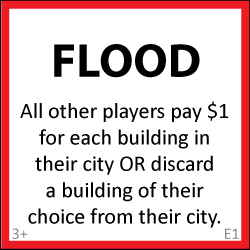 For Draftopolis, I originally allowed players to purchase resources directly from the bank at a steeper cost, but this added complexity and created awkward decision points where you had to decide whether it was worth it to pay extra to avoid helping out your neighbor. I eventually settled on a replacement solution of allowing resources to be purchased from anyone at the table with a $1 transport fee for each player between the seller and buyer. If a commodity such as Steel isn't being produced yet, then everyone is in the same boat of being unable to play tiles that require it. In addition, disaster tiles give players a way to affect players across the table, without introducing direct attacks or other mechanics that would call for political posturing.
For Draftopolis, I originally allowed players to purchase resources directly from the bank at a steeper cost, but this added complexity and created awkward decision points where you had to decide whether it was worth it to pay extra to avoid helping out your neighbor. I eventually settled on a replacement solution of allowing resources to be purchased from anyone at the table with a $1 transport fee for each player between the seller and buyer. If a commodity such as Steel isn't being produced yet, then everyone is in the same boat of being unable to play tiles that require it. In addition, disaster tiles give players a way to affect players across the table, without introducing direct attacks or other mechanics that would call for political posturing.
7. Militaristic neighbors can further invalidate strategies.
When a player wins with the military strategy in 7 Wonders, it's often because one or both of their neighbors chose to eschew building red cards at all, letting them get maximum military points with a very small investment. On the other hand, neighbors who are willing to fight for military superiority put a player into a decidedly worse position pretty much from the get-go.
Draftopolis allows full control over trade routes (by making it a permanent feature of the game board rather than a card that must be drafted) as well as the cross-table resource purchasing, so players have the tools to react to any situation that their neighbors might create for them. Sometimes trade routes will be hugely valuable, and sometimes it's better to cluster one's buildings to make them easier to protect with Fire or Police Departments. Complaints about table position have been few and far between in my experience.
8. The pass direction is inconsistent.
When I watch new players try out 7 Wonders, the number one rule I see them mess up is the swapping of the pass order in the second era. Even experienced players often forget which way the cards are being passed, which can slow down the game or cause issues with the packs as they travel around the table.
I originally had cards being passed the opposite way in the second era in Draftopolis, but eventually came to the conclusion that always passing left is simply better for the game. It's easy to remember and makes it clear which neighbor you should be paying attention to when settling on a plan. In games where you play your drafted cards immediately, you have perfect information about what strategies your neighbors are pursuing, and therefore you can always make an informed decision.
9. More players mostly just means more copies of the same cards.
This does ensure that you're playing the "same game" when there are more or fewer people, but it's also boring, and it relates directly to the next most common rules mistake that I've seen: people playing second copies of the same card. Double checking that each card you want to play doesn't have the same name as a card you already have is both time consuming and not particularly fun.
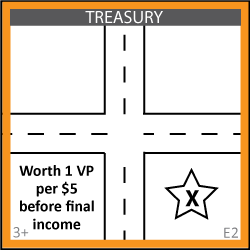 In Draftopolis, every tile is unique, and each additional player results in new possibilities and potential city configurations. There also aren't any rules that prevent the selection of a tile because of tiles already present in a city. Games with different numbers of players each have their own unique flavor, and certain strategies are slightly stronger or weaker depending on the number, further increasing the replayability of the game. For example, the Treasury is only available with five or more players, and it enables a strategy focusing on Commercial buildings that produce lots of upfront cash as opposed to a more traditional build favoring high income tiles.
In Draftopolis, every tile is unique, and each additional player results in new possibilities and potential city configurations. There also aren't any rules that prevent the selection of a tile because of tiles already present in a city. Games with different numbers of players each have their own unique flavor, and certain strategies are slightly stronger or weaker depending on the number, further increasing the replayability of the game. For example, the Treasury is only available with five or more players, and it enables a strategy focusing on Commercial buildings that produce lots of upfront cash as opposed to a more traditional build favoring high income tiles.
10. With 6+ players, you never see the same pack twice.
Last but not least, with six or more players in 7 Wonders, you'll never see the packs that you open ever again. And with seven players, there will be packs opened next to you that never make it to you even once. This cuts out a significant aspect of drafting strategy ("tabling" cards) and contributes strongly to the perception that there's nothing you can do about someone across the table who's doing well.
Of course, this problem is easy to "solve" by just adding tons of cards (or tiles) to each pack, but that comes with its own set of problems: choices being overwhelming, the play space getting too crowded, etc. For these reasons I started testing Draftopolis also with seven tiles per pack, but I soon settled on the sweet spot being eight. Any more and it starts getting difficult to fan them out in your hand, any fewer and you start losing the "tabling" aspect as mentioned above. With the maximum number of players (six) you still get a second tile out of each of your opening packs, and with three players you even get a third.
In conclusion...
Draftopolis is a game that borrows heavily from 7 Wonders in many respects while simultaneously attempting to strike out in a bold new direction. It plays quickly but has far reaching depth, and after hundreds of games I still find myself agonizing over turns with regularity. I'm also starting to think seriously about looking for a publisher, so hopefully you'll be able to play a tabletop version of the game sometime within a year or two. Thanks for reading and I'd love to hear other takes on both 7 Wonders and my proposed solutions in the comments!
indiecade + board game designs update
On Friday I'll be giving a talk at IndieCade alongside Chris Hecker entitled A Dialogue on Depth. It's rather surreal to see my name in a list with a bunch of indie luminaries, but hopefully I'll be able to live up to expectations. As Chris pointed out, though, we're in a timeslot opposite the Experimental Gameplay Workshop, and pretty much everyone in their right mind will be over there, so it should be a small and intimate gathering. Thanks to that we're planning on involving the audience during the talk.
Also wanted to give a quick update on my various boardgame designs:
City Draft - This 7 Wonders inspired drafting game is consistently liked in playtests and has been improving slowly and steadily. I've recently changed the rules to allow players to buy resources from any other player at the table, which opened up the possible strategies nicely and evokes a more interactive feeling in the gameplay. I'm also playing around with adding more "build around me" tiles that come early in the game, so that players can have a direction and get especially excited about tiles that they might be able to pick up later. At the most recent playtest, one 7 Wonders fan said that he actually liked this game better, and another player mentioned that she couldn't wait to buy it in stores, so hopefully that will happen sometime soon.
Prison Break - This is the experimental cooperative game with restricted communication (for the first half) and realtime aspects (for the second half). I thought I was onto something here after I hit a design breakthrough a few weeks ago but I'm getting discouraged again based on recent playtests. The game feels too easy, doesn't have enough strategy, and doesn't seem to quite evoke the feelings that I'm looking for. I think I need to go back to the drawing board on some of the core mechanics and try to find something that's more interesting and involved. Maybe I'll get a chance to playtest it at IndieCade and see if people have some ideas.
Dungeon Game - This 1v3 competitive game has a great core mechanic and then a thick layer of RPG elements and high variance on top of it. I'm currently torn as to whether or not the added complexity from the RPG elements is worth it. Dan Kline was already inspired by the core mechanic to work on a much simpler version of the game with a different theme, so I think I'm going to keep this as a dungeon crawl for now, and look for ways to simplify the game without losing much of the flavor and depth. I think the greatest chance of this design seeing the light of the day is to pitch it to Wizards of the Coast as a good fit for the D&D IP, so I'll be looking to do that next time I'm in Seattle. People who enjoy RPG experiences tend to have a great time with it.
I also have one more design that's currently in Cryptozoic's queue for publication, so with any luck I'll have a couple more games out in the market in the next year or two. Good times!
sprite wars, gamers vs evil, and PAX
After three ink cartridges, twenty five sheets of perforated business card paper, and a whole lot of work in Illustrator, the business cards are finally done. There are currently 50 unique cards, and I'll be bringing five copies of each to PAX (with the exception of a group of ten that lost one each of their comrades in the process, so those will be a bit rarer than the rest). I'm calling the game Sprite Wars, and the rules set is a fairly simple modification of Tic-Tac-Toe.
You're probably raising one eyebrow and muttering something like, "Interesting..." right about now. Why Tic-Tac-Toe, a game that no adult in their right mind plays with each other, that is solved and always results in a draw? Well, I had a few goals in mind for the game:
- Players should be able to learn it very quickly, ideally from just watching someone play.
- It should be playable in only a couple of minutes.
- It should only require a few cards per player.
- It can't require any sort of additional materials and should be playable on pretty much any small flat surface.
These are wildly different goals from most TCGs that you would find in your local store. Whenever I'm trying to make something that people can pick up extremely quickly, I find it makes a lot of sense to start from a game that everyone is familiar with and innovate from there. In this case, the image of little pixel characters surrounded by arrows pretty much instantly popped into my mind, which took me in the direction of using the rules and victory condition of Tic-Tac-Toe.
Those who follow me on Twitter might have seen me agonizing over the design of the front of the cards. I wanted something to ensure that people looking at the front would notice the back, ideally in an organic manner so that I wouldn't have to keep repeating "and look at the back too!" to everyone. Originally I had small text at the bottom saying "flip me over!", but it made the card feel cramped and I had to squeeze multiple things on one line. After a bunch of advice I ended up just going with some simple arrows on the sides; they don't explicitly tell anyone to turn over the card, but they hint at it and they nicely reference the arrows on the back that drive the gameplay.
That said, I now regret adding them. What I didn't realize is that I was going to have some issues with getting the printing to line up, especially on the fronts (which I printed second, regrettably after waiting a few days, giving the ink-laden paper time to warp). Without the arrows, small differences in alignment wouldn't have been noticeable. With them, it's sadly obvious, and worse, it "marks" the cards for the game because savvy players will be able to remember the arrow placement on their different cards and know what they're about to draw. Then again, this is just a free game on the back of my business cards, so it's really not that big of a deal, but it's a good lesson for the future.
All told it probably cost around $60 or $70 in ink and paper for 240 cards, which seems like a lot, but for full color, double sided cards with 50 different unique designs, I'm pretty happy with how it turned out. I'll be giving them out at PAX this weekend, so if you're there, say hi! I'll be a part of two talks at PAX Dev: Practical Systems Design in the Context of Darkspore (scintillating title I know) and Design Doc Do's and Don'ts, where I'll be talking about everything but traditional design docs. At PAX itself I'll be spending a lot of time at the SpyParty booth, or perhaps at the Cryptozoic booth as well, where they'll have some early copies of The Penny Arcade Game: Gamers Vs Evil, a game that I designed along with some help from Mike Donais and Matt Place.
It's firmly in the deckbuilding genre, and takes inspiration from games like Dominion and Thunderstone, but also adds its own twist to things with mechanics like facedown unique boss loot and player avatars that grant a special ability and determine the composition of your starting deck. I've been a huge fan of Penny Arcade for as long as I can remember, so it was a huge honor to design this game for them. Can't wait for people to get a chance to try it out!
the curse of cooperation
Cooperative multiplayer is an oft-underused method of allowing people to play games together in a more accessible and casual manner. People are starting to warm up to it, though, and recent years have seen a surge of cooperative board games, as well as digital games like Starcraft 2 and League of Legends that are embracing co-op vs AI as a valid way to experience the game. There's something nice about winning or losing together with your friends, especially when one isn't in the mood for the intensity and cutthroat qualities of a typical competitive experience.
That said, there's a particular problem that's endemic to cooperative board games, which is that the game will present players with a puzzle, hoping that the group will work together to find a solution, and instead the single most skilled or most experienced player will end up playing for the entire group. It's just much simpler for a single person to execute a strategy than it is to get everyone on the same page and let them arrive at the best course of action themselves. Many games give each player a hand of cards, but in the absence of a rule that prevents discussing those cards, they often are just laid openly on the table to save everyone the trouble of having to continually ask what everyone else has. If I remember correctly, Pandemic actually recommends laying the cards down on the easy difficulty and then asks that players hold them in their hand on medium and above, but still doesn't restrict players from talking about them. That does help a little; players at least get to feel somewhat involved when they're asked how many red cards they have rather than simply told what to do.
Not to say that those games aren't well designed and enjoyable overall. The list of games suffering from this problem is quite long: Pandemic, Forbidden Island, Ghost Stories, Castle Panic, Castle Ravenloft, and so on. Both Pandemic and Ghost Stories are heralded as some of the best cooperative experiences out there, especially when playing with people of roughly equal experience and skill levels. Still, any designer thinking about the cooperative space should have this problem at the forefront of their mind.
Of course, many games have also managed to solve this problem, either intentionally or as a side effect of another mechanic. There are three methods of varying degrees of commonality:
The traitor - Betrayal at House on the Hill, Shadows Over Camelot, Battlestar Galactica, etc. Add in the fact that one or more players are secretly a traitor and suddenly players are no longer keen on playing the game for everyone else. Or rather, no one's willing to let their turn be taken for them. Then again, adding in a traitor does add a competitive element to the game, which you may or may not want.
Real-time aspects - Space Alert is the king of this category. Not only are there hidden cards, but there's also a strict time limit and an audio track constantly throwing new challenges in the team's direction. Knowing this, Space Alert actually has the players appoint a captain, and everyone still gets to contribute fully because there's simply no way the captain has time to order everyone around.
Hidden information plus restricted communication - For example, adding a rule that says that players can't talk about the cards in their hand. Games seem to be hesitant to pull the trigger here, and I can't think of an example at the moment, although I'm sure there must be one out there. My guess is that it stems from concern that players will have trouble interpreting a rule like this, or worse that they'll outright rebel against it. Richard Garfield talked about this in a podcast on cooperative games and also mentioned the idea of "communication as a resource", which I've been thinking about ever since.
With the cooperative prison break game that I'm currently working on, there are two phases: the planning and the escape. For the planning phase players are forbidden to discuss the game at all, and cards are played face down, but each player has two tokens that they can spend to show everyone else a card from their hand and describe where they're stashing it. The goal is for players to try to work together as best they can, planning what they'll need for the escape, with that limited channel of communication.
When the actual escape begins, all restrictions on communication are lifted, but there's now a real-time element, with new obstacles showing up every fifteen seconds. Players have their objects in their hand and have to discuss what object or objects the group wants to use to solve that obstacle. Thanks to the timer combined with the hidden hands, players stay involved during this phase despite the open communication channels.
Initial playtesting has been good, and I'm confident that all players will be able to contribute throughout the game. Now to fine tune the rest of the mechanics...
elegance and armada d6
Elegance is a word that is used frequently in conversation by game designers, yet there has been very little written on the internet about elegance in game design. Some of that probably stems from the fact that it's hard to define. In fact, a high percentage of the discussion that does exist starts with a dictionary definition for that very reason. It's an easy launching point for talking about something nebulous. Mark Rosewater, the head designer for Magic: the Gathering, has an article on the subject, but even he seemed to steer towards writing rather than game design. (I'm not 100% sure, because for an article about elegance, the formatting was surprisingly tiresome and impenetrable.) He does follow the trend of starting with the definition, though, so who am I to differ:
Elegance is...
- refined grace or dignified propriety
- tasteful richness of design or ornamentation
- dignified, gracefulness or restrained beauty of style
- scientific precision, neatness and simplicity
- something that is elegant
Thanks, Merriam-Webster, for that fifth one. For the purposes of game design, the third definition speaks to me the most, with a touch of the fourth as well. So, dignity, grace, restrained beauty, style, precision, neatness and simplicity. Easy enough, right?
Jesse Schell also touches on elegance in his esteemed book, The Art of Game Design. "We call simple systems that perform robustly in complex situations elegant. Elegance is one of the most desirable qualities in any game, because it means you have a game that is simple to learn and understand, but is full of interesting emergent complexity." He goes on to say, "You can easily rate the elegance of a given game element by counting the number of purposes it has." This seems like a reasonable rule of thumb for approximating elegance, although I think there is slightly more to it than that.
Here are my primary aspects of elegance as pertaining to game design:
- Simple rules that create emergent complexity.
- Single elements used for multiple purposes.
- Conform to player expectations.
Conforming to player expectations can take a variety of flavors, but it includes all sorts of common situations like using white/green/blue/purple rarity colors in your loot system, making higher numbers the more desirable result, or making the shotgun deal high damage at close range but no damage at long range. Why is this a factor in elegance? Because it frees up the minds of your players for understanding the other aspects of your system. The more you can make them feel at home, the more brainpower they'll have for appreciating what makes your game unique. (This is actually one of the toughest aspects of making a sci-fi RPG; you can't rely on the common fantasy elements like zombies, goblins, swords and bows that everyone understands.)
Victory points, a common mechanic in German board games, aren't particularly elegant because they are divorced from the theme and they serve only a singular purpose. For example, as mentioned in my post about 7 Wonders, the most elegant potential victory condition in that game would be completing the construction of your wonder, as that's what players will expect based on the name and theme. However, that would mean that the wonders would all need to be perfectly balanced against one another, and would heavily warp the mechanics towards either hurrying construction of your own wonder or somehow delaying construction of another player's wonder. Through the use of victory points, Antoine Bauza was both able to create multiple viable paths to victory and also give himself built-in tuning knobs for adjusting the effectiveness of each one.
During GDC I had the pleasure of playtesting a prototype of a board game, Armada d6, from Eric Zimmerman and John Sharp. The game just oozes elegance out of every pore, from the components to the mechanics, and was the catalyst to me writing this post.
So what is Armada d6?
It's a battle for space colonization where the ships are represented by dice. The basic game can be completed in as little as 10-15 minutes (or longer, depending on the level of aggression), and there's an advanced game that adds more depth. There are six different types of ships, each denoted by a different face of the die, with the lower numbers representing the hulks of the battlefield, slow but strong, and the higher numbers representing their fast and sleek opposites. Each ship can move a number of squares equal to its number, and combat is resolved by each player rolling a separate die and adding their ship number to it, with the lowest total winning. Colonization is achieved by surrounding a planet with multiple ships whose values sum to exactly the colonization number of that planet (always a number from 7-9, displayed directly on the planet).
So in total, each of the player's core dice is used for:
- Marking the location of a ship.
- Denoting what kind of ship it is and by extension the ability of that ship.
- Defining the exact speed of that ship.
- Defining the colonization potential of the ship.
- Defining the inverse combat potential of the ship.
You could easily imagine a version of this game created by less seasoned designers where the six ships each have their own individual stats contained in a chart off to the side. Maybe the 6 ship (scout) turns out to be a little too good with a colonization potential of 6, so with the chart you could adjust its colonization down to 5, and maybe give it a point of speed to compensate. In a different situation, opening up that flexibility would be a great move. But here the payoff of having the ships conform to their directly visible numbers is so strong that it's clearly the right decision. And since everyone has access to the same ship options and there is a built-in way to reroll your ships, small imbalances are hardly even a problem. With the base components supporting five different purposes, using Jesse Schell's definition of elegance, Armada d6 is already off to the races.
As for simple rules that create emergent complexity, the game excels at both sides of the equation. It provides you with a clear goal (maneuver your ships with a certain summed value next to a planet with that number) and leaves it up to you to find the solution. Everything except for the special abilities is right there on the game board; since the speed and colonization potential are both equivalent to the visible number on the die, planning high level strategy is a breeze. The more accomplished players can start to explore the possibility space that the special abilities open up, with options like transporting other ships, free ship rerolls, or retrofitting to a ship that's one number higher or lower. Every turn is a puzzle with variable difficulty settings -- the easy level is focusing just on your ship numbers and moving them to a nearby planet, the medium level is starting to consider the ship abilities and how they affect your plans, and the advanced level is looking at your opponents and what they're trying to set up, and seeing if you can disrupt it with a few well-placed attacks.
For conforming to player expectations, there is only one flaw: that combat both rewards lower ship numbers and asks you to roll low for success. I always strive to avoid this in my designs. That said, there are successful games that utilize a similar system (Axis & Allies) and the payoff of having the speed/combat potential tradeoff inherent in the ship's value is more than worth it here.
One potential upgrade in terms of elegance would be to eliminate the need for outside dice during combat by rolling the ship itself. Of course, there are three obvious problems with this: it requires you to remember where your ship was, it requires you to remember what type of ship it was, and it makes it harder to do the combat math since your ship's combat value is no longer visible when you're figuring it out. Three strikes is enough to convince me that Eric was correct in leaving it out, but it's a worthwhile thought experiment to consider.
In the advanced game there's a mechanic where you can unlock advancements, and each time that happens you could either research one out of three technologies randomly (chosen from a personal pool of five at the beginning), or add one to your maximum number of ships (plus deploy a ship immediately), or add one to your number of actions starting next turn. The problem I discovered during the playtest was that for the most part it was just better to take the extra action every time. Taking extra ships didn't help because you needed actions to take advantage of having more ships, and the technologies were of varying usefulness so a random one was too risky. This is a common problem with action-based games, such as Agricola, although it's handled rather elegantly and thematically in that game. Adding a member to your family requires constructing an additional room in your house, taking a family growth action that's restricted in availability, and has an ongoing upkeep cost of additional food, so the extra action ends up being reasonably balanced (although still quite strong).
But back to Armada d6. One of the proposed solutions was that you couldn't ever have more actions than you had ships (you started with three of each). We dismissed this quickly, but I want to highlight why, as it can be very tempting to add rules like this when designing a game:
- Rules like this are usually applied as a band-aid to mitigate a more systemic problem with the game. This is pretty much the opposite of elegance and leads to them feeling tacked on.
- These rules tend to be hard to remember because they often have no association with the theme or flavor of the game.
- They often restrict player choice. In this case the player will generally only take a ship upgrade with the plan of taking an action upgrade next, which puts them on a specific pattern and makes what should be a three-pronged choice into a binary choice instead. Ideally the three upgrade paths should be balanced more organically.
We also discussed increasing the power of the other upgrades to make the choice more interesting, as in letting you choose your technology or giving you two extra ships if you choose that upgrade. Eventually, though, another group of players (Jason Rohrer and Christina Norman I think) suggested another idea, which was to roll both the extra actions and the extra ships into the technology system, and rather then forcing the player to make a somewhat awkward choice about personal techs at the beginning, instead just place a global random selection of techs off to the side of the board. Players can choose the one they want when they earn an upgrade and then the chosen tech is replaced with another random one. That way players are a lot more invested in the tech choices of their opponents, they can try to race for desirable techs, and they can't just continually choose to take extra actions since they're limited by the current selection.
In conclusion: elegance is a truly desirable quality in a game, although it shouldn't be pursued to the exclusion of all else. Armada d6 is one of the most elegant games I've ever played and is clearly the result of a series of strong design choices. I know Eric and John are currently looking for a publisher and I wish them the best of luck, because I look forward to playing more!
(Photos by Richard Lemarchand and John Sharp.)
the seven pillars of drafting-based games
Some time ago I played Fairy Tale for the first time. It's a game designed by a former professional Magic player named Satoshi Nakamura, and it's based around drafting, which is a format that has fascinated Magic players since the game's creation. Drafting is the perfect mix of luck and skill, with infinite replayability because every draft presents wildly different situations and challenges. In fact, there are sites online where you can draft Magic over and over against AI opponents that learn over time from the picks made by humans. The only problem with these sites is that, as fun as drafting is, it loses something when there's no validation at the end of the draft as to how successful you were.
Fairy Tale takes a stab at providing a more casual drafting experience with some quick resolution at the end of each round and a simple victory point system for determining a winner. It's a fun game, but after playing it a couple more times a month ago I felt like drafting games deserved more exploration. The problem was, I didn't have a great sense of how to make drafting compelling as the main feature of a game. In both Magic and fantasy football, it's used simply to distribute resources, with other mechanics carrying the bulk of the weight. Like Fairy Tale, I wanted the bulk of the strategy and decision-making to happen during the draft, with the resolution phase just providing a quick injection of validation to the process.
 I had an idea for a simple game almost immediately, so I created a prototype and played a few games. Cards were split into three types and assigned a base value, a bonus value and a conditional. You first drafted three packs worth of cards, then shuffled up your deck and played a modified version of War where you have three piles in front of you. (I wanted to try the extreme of not having any decisions in the resolution phase at all.) Based on the three cards you had visible, the conditionals of your cards might or might not trigger, which would determine if you got the bonus points. The highest total in each round would win a point card with a random value. One of the three types focused on low base values and high bonus values, another focused on the opposite, and a third was average in both.
I had an idea for a simple game almost immediately, so I created a prototype and played a few games. Cards were split into three types and assigned a base value, a bonus value and a conditional. You first drafted three packs worth of cards, then shuffled up your deck and played a modified version of War where you have three piles in front of you. (I wanted to try the extreme of not having any decisions in the resolution phase at all.) Based on the three cards you had visible, the conditionals of your cards might or might not trigger, which would determine if you got the bonus points. The highest total in each round would win a point card with a random value. One of the three types focused on low base values and high bonus values, another focused on the opposite, and a third was average in both.
Right around that same time I started hearing about a game called 7 Wonders that claimed to let seven people play a game in half an hour. Turns out 7 Wonders is a wonderfully crafted drafting game that advanced my understanding of this budding genre by leaps and bounds. Having played both it and my prototype around five times each now, here are my thoughts on the seven most important aspects to keep in mind when designing a game based around drafting:
1. Card types that do wildly different things so that the draft choices are not just straight comparisons.
My prototype: All cards had the same point numbers on them. This was simple but it made almost every decision into just a straight expected value calculation. The EV of each card was the base value plus the bonus value times the chance of succeeding on the conditional. The types could change that a little bit if you were setting up for a certain strategy, but not nearly enough. This was a disaster.
 7 Wonders: There are many different card types (resources, science, military, civilian, commercial, guilds) and almost as many ways to score victory points. While this does add complexity, it's key to making the draft choices interesting. For example, think about a fantasy football draft where you're only drafting quarterbacks. It breaks down into a straight EV calculation to try and decide which QB will give you the highest number of average points each week. When you add in all the other positions, though, you have to think about what positions are being drafted aggressively, which ones you can leave for later, which positions generally score more points, and which ones have large point differentials between the strong players and the weaker ones.
7 Wonders: There are many different card types (resources, science, military, civilian, commercial, guilds) and almost as many ways to score victory points. While this does add complexity, it's key to making the draft choices interesting. For example, think about a fantasy football draft where you're only drafting quarterbacks. It breaks down into a straight EV calculation to try and decide which QB will give you the highest number of average points each week. When you add in all the other positions, though, you have to think about what positions are being drafted aggressively, which ones you can leave for later, which positions generally score more points, and which ones have large point differentials between the strong players and the weaker ones.
2. Rare cards that can excite drafters and give them a direction.
 My prototype: In the first version I tried balancing almost all of the cards against each other, but players had no obvious direction and weren't excited about any of the cards that they got. Perhaps unsurprisingly, the fact that Magic has cards that are somewhat obviously better than others and also rare cards that are labeled as such are both key to making draft more dynamic and interesting. There's no better feeling than opening that "bomb rare" out of a Magic pack. That said, it is a little more dangerous to have overly strong cards in a drafting game where the card will automatically come up. There is a lot of variance in what cards appear in a game of Magic, and also a decent number of cards that can answer the bombs. Still, in the second version of my prototype I added a second deck of powerful and narrow rare cards and created each pack with five commons and two rares. This was a huge improvement.
My prototype: In the first version I tried balancing almost all of the cards against each other, but players had no obvious direction and weren't excited about any of the cards that they got. Perhaps unsurprisingly, the fact that Magic has cards that are somewhat obviously better than others and also rare cards that are labeled as such are both key to making draft more dynamic and interesting. There's no better feeling than opening that "bomb rare" out of a Magic pack. That said, it is a little more dangerous to have overly strong cards in a drafting game where the card will automatically come up. There is a lot of variance in what cards appear in a game of Magic, and also a decent number of cards that can answer the bombs. Still, in the second version of my prototype I added a second deck of powerful and narrow rare cards and created each pack with five commons and two rares. This was a huge improvement.
7 Wonders: This is one area where I feel 7 Wonders falls a little short, although the double resource cards fill this role to an extent, and the starting resource and wonder requirements help as well.
3. Not having to memorize or continually look at a bunch of hidden cards.
My prototype: It was easy for me to fall into the trap of having a hidden pile of cards that you're creating as you draft the cards, since that's how Magic works. Worse, a lot of the cards you could potentially draft depended heavily on you knowing the contents of that pile to properly evalutate them. So players had to keep picking up the pile and sifting through it to remember what they had drafted.
7 Wonders: Uses an obvious but elegant solution of just playing the card immediately and resolving the effects. One of the great things about this is that you get immediate payoff from each card you draft rather than having to wait until the end of the pack or the end of the draft. You do lose some strategy in trying to figure out what your opponents are drafting, but that's a pretty subtle skill that isn't necessary for a compelling experience.
4. Not having to draft and/or play every card.
My prototype: The final card of each pack is discarded. I also tried having players draft all of the cards and then letting them cut some from their deck, but that was too much work for not enough payoff, especially since it just came down to EV calculations again.
7 Wonders: Turns out that the designer of 7 Wonders came to the same conclusion, as the final card of each pack is also discarded. On top of that each drafted card can be sold for coins or placed facedown as a section of the wonder itself, which allows savvy players to "hate draft" (taking a card that would be good for a neighbor) and also mitigates the bad feelings of getting a pack that doesn't have anything that they really want.
5. Cards that have different amounts of value to different people.
My prototype: I was actually reasonably successful here with the conditions. Someone who was trying to draft an "A deck" would value a C type card wildly different than someone else. There was some amount of skill in trying to find the underdrafted archetype.
 7 Wonders: There are tech paths that are represented through certain buildings in the game allowing you to build other buildings for free. They aren't necessary to succeed (you can always pay for the building the hard way) but they provide a clear reason why one player really wants a certain card whereas another might not. Additionally, science gives victory points in a way where the value of the science buildings fluctuates wildly from one person to the next. And finally, military varies from being incredible (when you're slightly behind your neighbors) to useless (when you're either far ahead or far behind both neighbors).
7 Wonders: There are tech paths that are represented through certain buildings in the game allowing you to build other buildings for free. They aren't necessary to succeed (you can always pay for the building the hard way) but they provide a clear reason why one player really wants a certain card whereas another might not. Additionally, science gives victory points in a way where the value of the science buildings fluctuates wildly from one person to the next. And finally, military varies from being incredible (when you're slightly behind your neighbors) to useless (when you're either far ahead or far behind both neighbors).
6. The opportunity to change your strategy based on what other people are doing.
My prototype: Sadly, not much of this exists. At some point I added conditionals that depend on the active cards of your neighbors, which helps, but it's hard to tell what they're doing anyway. It's all far too subtle.
7 Wonders: There is a mechanic where players can buy resources from their neighbors, so right off the bat you're intrigued by what sorts of resources your neighbors have chosen to develop. Then there are markets, which allow you to buy more cheaply in either or both directions. And of course, science rewards you heavily for jumping in when it's underdrafted, and military rewards you for staying slightly ahead of your neighbors.
7. Players should start the game from different positions.
My prototype: This one didn't make it into my prototype design, but I think it's a strong tool for accomplishing multiple other goals as well as adding replayability.
 7 Wonders: Each player is attempting to build a different wonder, which determines both a starting resource and also a set of costs and rewards for building stages of the wonder. As mentioned above, this helps give a starting direction and also helps with players having different value for cards. Completing your wonder would have been a more flavorful victory condition, but relying on victory points instead does allow the game to keep wonder building as an optional task, which means that wonder balance doesn't have to be perfect. If you get one you don't like you can just focus on other goals for that game.
7 Wonders: Each player is attempting to build a different wonder, which determines both a starting resource and also a set of costs and rewards for building stages of the wonder. As mentioned above, this helps give a starting direction and also helps with players having different value for cards. Completing your wonder would have been a more flavorful victory condition, but relying on victory points instead does allow the game to keep wonder building as an optional task, which means that wonder balance doesn't have to be perfect. If you get one you don't like you can just focus on other goals for that game.
So there you have it. If you can't tell, I found my prototype to be fairly terrible (although illuminating) and 7 Wonders to be relatively exquisite. I highly recommend it. One of my only complaints about the game is that you can't "table" cards in larger games. (Meaning to see a card early in a pack and then still have a chance of getting it later when the pack returns to you.) However, it's not clear if the benefits of tabling outweigh the disadvantage of players having to deal with much larger pack sizes. Magic gets away with fifteen card packs because of rarity and colors; rarity shifts the focus heavily to the rare when you first open a pack, and colors narrow the relevant cards pretty quickly once the draft gets going. 7 Wonders has neither, so a smaller pack size makes sense.
As always, I've rambled on a bit much at this point, so let me know in the comments if you disagree with any of these "pillars" or if you have your own ideas about the genre.


